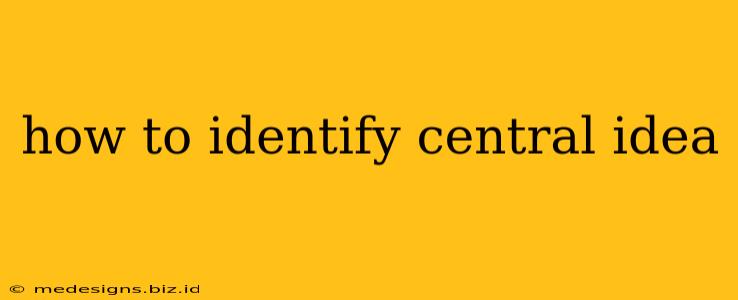Identifying the central idea, also known as the main idea or thesis statement, is a crucial skill for reading comprehension and critical thinking. Whether you're tackling a complex academic text, a news article, or a captivating novel, understanding the central idea unlocks a deeper understanding of the text's purpose and meaning. This guide will equip you with effective strategies to pinpoint the central idea in any piece of writing.
What is a Central Idea?
The central idea is the main point or overall message the author wants to convey. It's the overarching theme that governs the entire piece, providing unity and coherence to all the supporting details and arguments. Think of it as the core argument the author is trying to make. It's not just a single fact or detail, but rather a comprehensive statement summarizing the author's purpose.
Strategies for Identifying the Central Idea
Here are several effective strategies to help you identify the central idea:
1. Read Actively and Carefully:
- Annotate as you read: Underline key phrases, circle unfamiliar words, and jot down brief notes in the margins to summarize sections. This active reading approach helps you engage more deeply with the text and identify important themes.
- Pay attention to the title and headings: These often provide clues about the overall topic and the author's focus.
- Look for repetition: The author may repeat key words or phrases to emphasize important concepts. This repetition signals the core message.
2. Analyze the Supporting Details:
- Ask yourself: "What are the main points the author is trying to make?" The supporting details and examples will all relate back to the central idea.
- Identify patterns and connections: Notice how the different paragraphs or sections relate to one another. How do they build upon each other to support a larger point?
- Consider the author's purpose: Why did the author write this piece? Understanding the author's purpose will help you identify the main point they are trying to convey.
3. Summarize the Text:
- Create a brief summary: After reading, try to summarize the text in one or two sentences. This exercise will force you to identify the most important information and articulate the main point.
- Identify the most important information: What are the key concepts, arguments, and examples? The central idea will be the umbrella under which these fall.
4. Look for Topic Sentences:
- Topic sentences often provide a roadmap: In many texts, the first sentence of a paragraph will state the main idea of that paragraph. By identifying these topic sentences, you can begin to assemble the overall central idea.
- Beware of exceptions: Not all paragraphs will have explicit topic sentences, and sometimes the main idea is implied rather than explicitly stated.
5. Consider the Conclusion:
- The conclusion often summarizes the main points: The author may restate the central idea in a more concise or impactful way in the conclusion.
- Look for a final statement: What is the author's takeaway message? This often indicates the core argument of the text.
Practicing to Master Identifying Central Ideas
The key to mastering the identification of central ideas is practice. The more you practice, the more efficiently and accurately you will be able to identify them. Work on a variety of texts, from different disciplines and genres, to broaden your skills. Challenge yourself to summarize complex texts and articulate the central idea in your own words.
By utilizing these strategies consistently, you will significantly improve your ability to identify the central idea in any reading material. This skill is invaluable for academic success, effective communication, and a deeper appreciation of literature.
